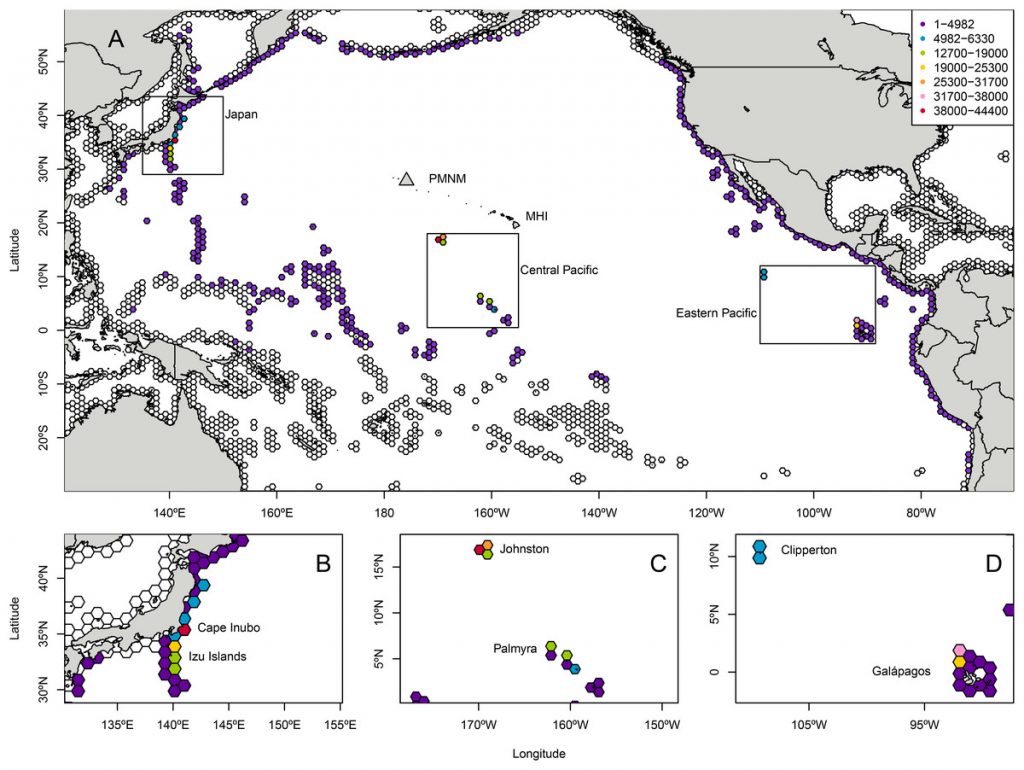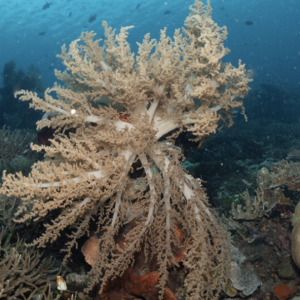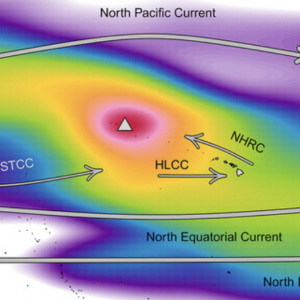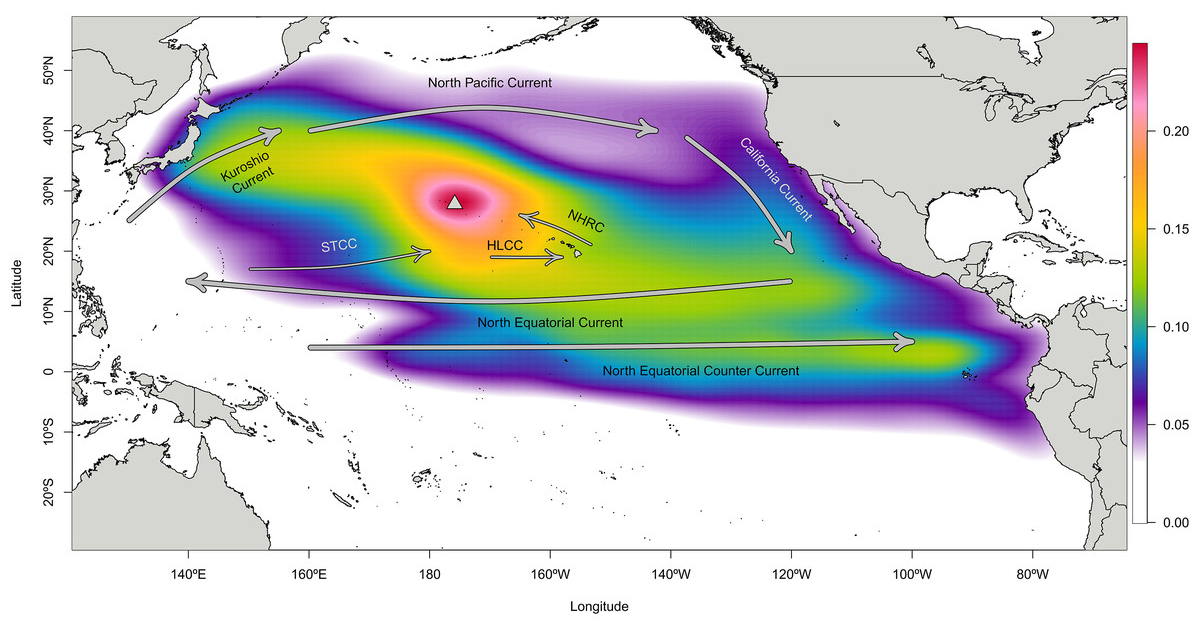A predictive framework for identifying the source populations of Chondria tumulosa, a cryptogenic red macroalga that has been rapidly overtaking coral reef ecosystems in Hawai‘i's Papahānaumokuākea Marine National Monument
The cryptogenic marine red alga Chondria tumulosa was first observed in 2016 in subtidal habitats at Manawai (Pearl and Hermes Atoll) in the Papahānaumokuākea Marine National Monument (PMNM), Hawai‘i. Without molecular or morphological matches to any known species, it was described in 2020 and declared cryptogenic. This alga has substantially increased in benthic cover and has been discovered on two additional atolls in PMNM: Kuaihelani (Midway) and Hōlanikū (Kure).

In the Press

New Research Identifies Potential Source Populations of Invasive Red Alga
.

New research identifies potential source populations of invasive red alga threatening Hawaii's protected coral reefs
“Understanding the origin of this potentially invasive species is crucial for developing effective management strategies,”
For All Readers - AI Explainer
Tracking the Origins of an Invasive Alga: A Q&A on Chondria tumulosa Research
Understanding the Threat to Hawaiian Coral Reefs
In recent years, a mysterious red alga has been wreaking havoc on the pristine reefs of Papahānaumokuākea Marine National Monument (PMNM) in Hawaii. First discovered in 2016, Chondria tumulosa has rapidly spread across the northernmost atolls, smothering coral and threatening marine ecosystems. But where did this destructive species come from? Researchers have been working to solve this mystery, and their findings offer important insights for conservation efforts.
What is Chondria tumulosa and why is it concerning?
Chondria tumulosa is a red alga first observed at Manawai (Pearl and Hermes Atoll) in 2016. It’s a relatively new species to science, formally described by Sherwood and Huisman. What makes this alga particularly concerning is its invasive characteristics – it forms large, robust mats that can smother and kill coral colonies. Since its discovery, it has spread to other atolls in the Papahānaumokuākea Marine National Monument, covering hundreds of acres of reef and causing massive damage to these protected ecosystems.
How is Chondria tumulosa different from other algae species?
Chondria tumulosa has distinctive morphological characteristics that set it apart from the other 113 species in the Chondria genus. It features large, robust thalli (plant bodies), a mat-forming tendency, and terete (cylindrical), bluntly rounded axes with decreasing diameter with each level of branching. These characteristics are maintained whether the species occurs in high densities or more cryptically hidden among other marine life.
Is Chondria tumulosa native to Hawaii?
That’s the big question researchers have been trying to answer. The evidence suggests it’s likely not native to Hawaii. Despite being well-established in PMNM, there are no historical records of this species in the region before 2016, and its sudden appearance and rapid spread are characteristic of non-native species introductions. However, confirming its origin has been challenging because, despite extensive searching, researchers haven’t found it anywhere else in the world yet.
How are researchers trying to identify the source of this invasive alga?
The research team used an innovative approach combining:
- Oceanographic modeling: They used computer simulations to track potential marine debris pathways across the Pacific Ocean, incorporating real-world GPS data from tagged flotsam to optimize the model.
- Environmental DNA (eDNA) surveys: Researchers collected water samples from potential source locations to test for genetic traces of Chondria tumulosa.
- Herbarium examinations: They examined preserved algae specimens from collections around the world to look for historical occurrences of this species.
- DNA barcoding: This technique was used to identify collected specimens and compare them to the Chondria tumulosa found in Hawaii.
Were researchers able to confirm the presence of Chondria tumulosa in these potential source locations?
Despite targeted sampling efforts using eDNA surveys and examining global herbaria collections, researchers have not yet detected Chondria tumulosa outside of PMNM. This highlights the challenge of searching for a specific species across the vast Pacific Ocean. However, the absence of evidence doesn’t mean the species isn’t present in these locations – it could exist in low densities or in areas that haven’t been sampled.
How might Chondria tumulosa have been transported to Hawaii?
Marine debris is the most likely vector for transporting this alga across the Pacific Ocean. The research specifically modeled marine debris as a dispersal mechanism, and the results aligned with known debris pathways. Floating objects like plastic, fishing gear, or other debris can carry attached organisms over long distances before eventually washing up on distant shores.
What steps are being taken to prevent further spread of this invasive alga?
Researchers and conservation authorities are implementing several measures:
- Desiccation testing: Studies are being conducted to determine how long the alga can survive out of water, which helps inform decontamination protocols.
- Decontamination protocols: Equipment used in affected areas is being sterilized with 10% bleach solution to prevent accidental transfer.
- Monitoring: Ongoing surveillance helps track the spread and impact of the alga.
- Model-guided search strategy: The research team has proposed focusing future search efforts on the most probable source locations identified by their modeling.
Why is it important to find the source population of Chondria tumulosa?
Identifying the source population would provide several benefits:
- Prevention: Understanding where the species came from could help prevent future introductions.
- Management insights: Studying how the species behaves in its native range could provide clues for managing it in Hawaii.
- Risk assessment: Knowing its origin would help assess the risk of spread to other locations.
- Ecological understanding: It would provide context for understanding the species’ biology and ecological role.
What are the broader implications of this research?
This study demonstrates an innovative approach to tracking the origins of marine invasive species. By combining oceanographic modeling with biological sampling, researchers have created a framework that can be applied to other invasive species challenges. The research also highlights the vulnerability of remote marine ecosystems to invasions and the importance of biosecurity measures to protect these areas.
What are Article Spotlights?
Spotlighted articles are press released, and feature author interviews, AI explainers and more.
If you have published in Peer J and would like to be featured in an Article Spotlight please contact PeerJ.

